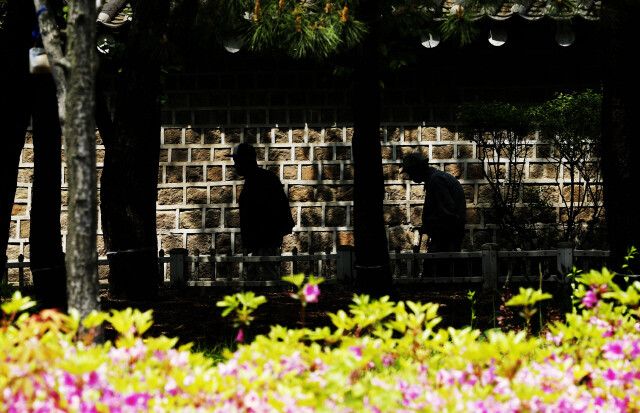hankyoreh
Links to other country sites 다른 나라 사이트 링크
Survey of Korean households shows intractability of elderly poverty

A 2015 survey on South Korean household finances and welfare shows slight improvements in income distribution indicators, but no change in the overall poverty rate.
Meanwhile, the rate of poverty among the elderly remained high amid an overall aging trend in the population, with mounting debt levels underscoring it as an issue in urgent need of resolution.
The South Korean poverty rate in terms of disposable income was calculated at 16.3% for 2014, the same level as in 2013. The rate, which refers to the percentage of people earning below 50% of the median income (the poverty line), or 11.56 million won (US$9,890) per year, stood at 16.5% for 2011 and 2012.
The poverty rate was also found to be strongly correlated with household size: 51.3% for one member, 32.6% for two, 14.5% for three, and 8.6% for four or more. The numbers suggest a decline in the poverty rate for larger households, which typically include more employed persons.
A slight improvement was observed in the Gini coefficient, which measures inequality in income distribution. The index for disposal income fell from 0.352 in 2012 to 0.347 in 2013 and 0.344 in 2014, with numbers closer to one indicating greater inequality.
The South Korean government is taking the changes as a sign that earned income tax credits for low earners and the basic pension for the elderly are having an effect. Indeed, the Gini coefficient for 2014, before the basic pension and other public transfer income was reflected, stood at 0.380, or 0.036 points higher than after. The “poverty gap,” a measure of deepening poverty that shows the difference between the poverty line and average income for the poverty class (7.47 million won/US$6,390), was calculated at 35.4%, down 1.1 percentage points from the year before.
But no change was observed in the Gini coefficient from the Statistics Korea household trend survey, which the government uses as an official indicator of income distribution. Instead, its level held steady at 0.302 from 2013 to 2014. Indeed, some have taken to calling the household finance and welfare survey-based measure a “new Gini coefficient” to distinguish it from the household trend survey version, which uses different subjects and methods.
In the latest survey, elderly poverty was once again shown to be a serious problem requiring priority policy consideration. While the percentage of people aged 66 and over living in poverty declined by 1.2 percentage points between 2013 and 2014, it still stands at 48.3%, or nearly half. South Korea currently ranks highest among OECD member countries in its elderly poverty and suicide rates.
Many impoverished senior citizens are finding themselves increasingly dependent on borrowing due to the lack of pension funds and other post-retirement social safety net features. Indeed, the average rate of increase in debt from the year before for households headed by an individual over 60 stood at 8.6% as of March 2015 -- a much higher level than the 2.2% rate for the population as a whole. The rate of increase in financial debt for elderly households holding such debt was also higher than average by a margin of 11.4% to 7.9%. The debt servicing ratio (DSR) for disposable income rose from 19.4% in 2013 to 23.8% in 2014. Among households with a retired head, just 7.9% described their living expenses as “comfortable,” while 41.7% rated them as “inadequate” and 20.4% as “extremely inadequate.”
“With such a high rate of economic activity among the elderly and few decent jobs, it is difficult to find a solution [to the poverty rate] other than increasing the public pension,” said Chung-Ang University social welfare professor Kim Yeon-myung.
“Given the increasing rate of consumption by the elderly, we might be able to decrease the poverty rate and boost domestic demand by expanding welfare to them,” Kim suggested.
By Lee Bon-young, staff writer

Editorial・opinion
![[Column] Park Geun-hye déjà vu in Yoon Suk-yeol [Column] Park Geun-hye déjà vu in Yoon Suk-yeol](https://flexible.img.hani.co.kr/flexible/normal/500/300/imgdb/original/2024/0424/651713945113788.jpg) [Column] Park Geun-hye déjà vu in Yoon Suk-yeol
[Column] Park Geun-hye déjà vu in Yoon Suk-yeol![[Editorial] New weight of N. Korea’s nuclear threats makes dialogue all the more urgent [Editorial] New weight of N. Korea’s nuclear threats makes dialogue all the more urgent](https://flexible.img.hani.co.kr/flexible/normal/500/300/imgdb/original/2024/0424/7317139454662664.jpg) [Editorial] New weight of N. Korea’s nuclear threats makes dialogue all the more urgent
[Editorial] New weight of N. Korea’s nuclear threats makes dialogue all the more urgent- [Guest essay] The real reason Korea’s new right wants to dub Rhee a founding father
- [Column] ‘Choson’: Is it time we start referring to N. Korea in its own terms?
- [Editorial] Japan’s rewriting of history with Korea has gone too far
- [Column] The president’s questionable capacity for dialogue
- [Column] Are chaebol firms just pizza pies for families to divvy up as they please?
- [Column] Has Korea, too, crossed the Rubicon on China?
- [Correspondent’s column] In Japan’s alliance with US, echoes of its past alliances with UK
- [Editorial] Does Yoon think the Korean public is wrong?
Most viewed articles
- 1‘We must say no’: Seoul defense chief on Korean, USFK involvement in hypothetical Taiwan crisis
- 2N. Korean delegation’s trip to Iran shows how Pyongyang is leveraging ties with Moscow
- 3‘Weddingflation’ breaks the bank for Korean couples-to-be
- 4[Reportage] On US campuses, student risk arrest as they call for divestment from Israel
- 5Amnesty notes ‘erosion’ of freedom of expression in Korea in annual human rights report
- 6[Column] Park Geun-hye déjà vu in Yoon Suk-yeol
- 7Korea sees more deaths than births for 52nd consecutive month in February
- 8[Editorial] New weight of N. Korea’s nuclear threats makes dialogue all the more urgent
- 9Will NewJeans end up collateral damage in internal feud at K-pop juggernaut Hybe?
- 10[Guest essay] The real reason Korea’s new right wants to dub Rhee a founding father